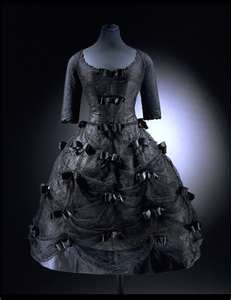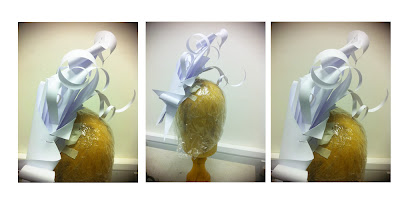Monday, 21 May 2012
Hat Talk Dillon Wallwork Diamond Jubilee Competition
Well I have to say I'm stunned, shocked and delighted to find out I have won third place in the Talenthouse competition organised by Dillon Wallwork and Hat Talk magazine. My idea was to make the ultimate paper party hat. Based around a bowler shape and made from papier mache, stamp images and lots and lots of diamond beads. It is being shipped as we speak to hat talk HQ to be photographed to go in a special Diamond Jubilee edition of the magazine. Then on to Hat Works hat museum in Stockport. I keep meaning to visit and keep forgeting, now I have the perfect incentive!
Feltmakers Award 2012
My entry for the anuual Feltmakers awards. Made with velour felt,wood and coque feathers. Inspired by nature, especially natural forms like ferns and seeds.
Monday, 14 May 2012
More Paper Hats - The Paper Hat Project
 |
| Paper toiles |
More paper hats, seems to be bit of a theme!
Tuesday, 8 May 2012
Liz's Love Life
 |
| 1950 First husband hotelier Conrad Nicky Hilton Divorced within the year |
 |
| 1952 Marries actor Michael Wilding 1953 Gives birth to first son 1955 Gives birth to second son |
 |
| 1957 Divorces Wilding marries Mike Todd 1957 Gives birth to a daughter 1958 Mike Todd is killed in a plane crash |
 |
| 1959 Marries singer Eddie Fisher. Who was formerly the husband of Debbie Reynolds |
 |
| 1961 Meets Burton on the set of Cleopatra |
 |
| 1964 Marries Burton |
 |
| 1974 Divorces Burton |
 |
| 1975 Remarries Burton |
 |
| 1976 Divorces Burton again ! |
 |
| 1977 Marries Republican wanna be senator John Warner |
 |
| 1988 Meets Larry Fortensky at rehab 1991 Marries Fortensky 1996 Divorces Fortensky |
Fashion and Celebrities of the Fifties
Fashion of the 50’s
Late forties into the fifties considered to be the golden
age of couture.
Textile design was heavily influenced by science and
technology. British designers such as the Aschers, team up with major artists
of the period to produce artists scarves and textiles. Artists include Picasso,
Matisse, Henry Moore, Miro
The impact of new artificial fabrics and fibres were felt in
the underwear and leisurewear industry. Nylon was one of the main fabrics used,
not just in tights but in men’s underwear, socks and sportswear.
Wear ability and easier laundering were key features.
In fashion the relationship between waist and hips, the neck
and shoulders become clear. Both show the same emphasis and contrast. A figure
of eight is repeated from top to toe – it was the same for high fashion and
discount of the peg clothes alike.
Fashion was moving slowly from the catwalks of Paris,
New York, Rome,
London and select boutiques into
the bigger shops and chain stores.
Mass production techniques and processes introduced in
wartime to fill bulk clothing order’s, were now going into action to supply new
domestic demand.
Quality in ready to wear garments was better. Increasingly
the haute couture designs seemed far removed from the actual world.
The clothing industry still paid attention to the major
fashion shows, taking one or two features from the collection and incorporating
them into their garments.
Soon it would be the streets that set the pace in fashion.
 |
| The Aschers |
 |
| Henry Moore Ascher Art Scarf |
 |
| Horrockses Fashions |
Noted designers of the fifties
Emilio Pucci, Christian Dior, Balenciaga ,Jaques Fath,
Pierre Cardin, Hardy Amies, Hubert De Givenchy, Pierre Balmain, Norman
Hartnell, Aschers, Horrockes, Bianchini Ferier, Digby Morton, Charles Creed,
Yves Saint Laurent, Nina Ricci, Aage Thaarup, Jaques Heim, Jeanne Lanvin, Elsa
Schiaparelli
 |
| Yves Saint Laurent for Dior |
 |
| Nina Ricci |
 |
| Lanvin |
Illustrators
Rene Grau
Photographers
Irving Penn, Cecil Beaton, Norman Parkinson
 |
| Cecil Beaton |
 |
| Irving Penn |
 |
| Norman Parkinson |
Living Dolls – The housewife of the 1950s
After WW11 there was a concerted move to persuade women to
leave their wartime jobs and return to looking after their family.
Women were encouraged not to compete with men
By the end of the 50s the media and TV were talking about
‘trapped housewife’ syndrome
The image of the housewife was that of a doll like figure, dressed in rustling
full skirts, nipped waist and narrow fitting bodice! Not the ideal outfit for
cleaning, cooking and childcare!
The idea was a woman should be able to catch her man with
her young, slim hourglass appearance, long legs all precariously supported on
stiletto heels!
Even working women adopted a fragile sloping shoulder line,
wearing a little hat with veiling and small gloves and handbags.
Celebrities of the 50s
Music
Elvis Presley, Buddy Holly, Etta James, Cliff Richard, Fats
Domino, Jerry Lee Lewis, Bobby Darin, Bill Haley and the Comets, Eddie Cochran,
Brenda Lee, Miles Davis, Frank Sinatra, Thelonius Monk, Johnny Cash, Charles
Mingus
Film Stars
Elizabeth Taylor Audrey Hepburn, Marilyn Monroe, Jane
Russell, Debbie Reynolds, James Dean, Marlon Brando, Doris day, Bridget Bardot,
Kim Novak, Pat Boone, Grace Kelly, Kay Kendall, Deborah Kerr, Jayne Mansfield,
Cyd Charisse, , Bing Crosby, Frank Sinatra, James Stewart, William Holden, Kirk
Douglas, Lauren Bacall, Gene Kelly, Natalie Wood, Montgomery Clift, Charlton
Heston, Gregory Peck
Top Films of the 50s
Vertigo, On the Waterfront, Seven Samurai, Bridge on the
River Kwai, Sunset Boulevard, All About Eve, Singin In the rain, Some Like it
Hot, A Streetcar Named Desire, Rebel Without A Cause, The African Queen, Ben
Hur, The Searchers, The Blackboard Jungle, The Wild One, The Seven Year Itch
Fashion of the Fifties Continued
Dior's New Look 1947
A Post War Turning Point in Fashion History
In 1947 Christian Dior presented a fashion look with a fitted jacket with a nipped in waist and full calf length skirt. It was a dramatic change from wartime austerity styles. After the rationing of fabric during the Second World War, Dior's lavish use of material was a bold and shocking stroke. His style used yards and yards of fabric. Approximately 10 yards was used for early styles. Later Dior used up to 80 yards for newer refinements that eliminated bulk at the waist.The New Look and new approach to fashion was a major post war turning point in Fashion History.
Dior's New Look of 1947 and the design called Bar.
Dior's timing made his name in fashion history. After the war women longed for frivolity in dress and desired feminine clothes that did not look like a civilian version of a military uniform. Life magazine dubbed Diors Corolle line the New Look in 1947. Evening versions of the New Look were very glamorous and consisted of strapless boned tops with full skirts and were ultra feminine.
The shaped fitted jacket Dior designed with his New Look full skirt was also teamed with a straight mid calf length skirt. Women usually wore just underwear beneath the buttoned up jacket, or filled in the neckline with a satin foulard head scarf, dickey or bib.
Dior's New Look dominated the fashion world for about ten years, but was not the only silhouette of the era. 1956 was the year that introduced visible changes that separate the early fifties from the late fifties. It places that fashion era firmly alongside the stuffy formality of the forties, whilst putting the post 1956 period firmly into the start of the livelier, anything goes sixties fashion period, often dominated by the young of the day.
There were those in the 1950s that rebelled against the pristine immaculate groomed look, so often associated with Grace Kelly elegance. Leslie Caron and Audrey Hepburn both often wore simple black sweaters, flat shoes and gold hoop earrings coupled with gamine cropped short haircuts. They gave a continental alternative often described as chic and had many fashion followers seeking to embrace the modern.
Paper Nylon and Net Petticoat Support 1950s
The full skirts needed support to look good and nylon was used extensively to create bouffant net petticoats or paper nylon petticoats. Several petticoats often of varying styles were worn to get the 'just right' look of fullness which progressed from a gentle swish to a round ball like bouffant effect by the sixties.Each petticoat was stiffened in some way either by conventional starch or a strong sugar solution. Eventually a hoop crinoline petticoat was developed and it had channelled tapes which were threaded with nylon boning in imitation of whale bone petticoats. A single net petticoat worn over it softened the look of the rigid boning.
The full skirts needed support to look good and nylon was used extensively to create bouffant net petticoats or paper nylon petticoats. Several petticoats often of varying styles were worn to create fullness
Another influential fashion silhouette of the period was that of the late 1940's swing coat by Jacques Fath, which was a great shape to cover up full skirts and an ideal silhouette for the post war high pregnancy rate.
This style was also often made as a loose full tent line duster coat, but often without the double breasted feature and buttons
Fifties Silhouettes
»
In contrast to the full skirted New Look, Chanel who had
reopened her fashion house in 1954 began to produce boxy classic Chanel
suit jackets and slim skirts in braid trimmed, nubbly, highly textured
tweeds. She used richly textured wool slub fabrics sometimes designed
by the textile artist Bernat Klein. The silhouette was straight down
and veered away from a nipped in waist.
The beautifully made suits were lined with lovely silk
fabrics.
They were weighted along the facing join and inside lining with
gilt Chanel chains.
The
fashion look was easy to copy and very wearable. Major chain stores
sold suits based on the design. Accessorized with strings of pearls the
style has frequently been revived over the seasons and in particular
a collarless style of coat and jacket she popularised, is now called the
Chanel line. The collarless Chanel line jacket was hugely popular
again in both the 1980s and the 1990s.
America
in particular bought Chanel's designs in large numbers. Her influence
of boxy suits of the fifties has far more bearing on sixties fashion
style,
than Dior's New Look design.
Subscribe to:
Posts (Atom)











































